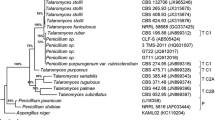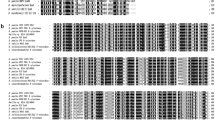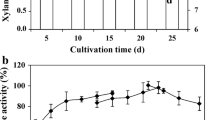Abstract
Corn stover that had been treated with vapor-phase diethyl oxalate released a mixture of mono- and oligosaccharides consisting mainly of xylose and glucose. Following overliming and neutralization, a d-xylulokinase mutant of Pichia stipitis, FPL-YS30 (xyl3-∆1), converted the stover hydrolysate into xylitol. This research examined the effects of phosphoric or gluconic acids used for neutralization and urea or ammonium sulfate used as nitrogen sources. Phosphoric acid improved color and removal of phenolic compounds. d-Gluconic acid enhanced cell growth. Ammonium sulfate increased cell yield and maximum specific cell growth rate independently of the acid used for neutralization. The highest xylitol yield (0.61 gxylitol/gxylose) and volumetric productivity (0.18 gxylitol/gxylose l) were obtained in hydrolysate neutralized with phosphoric acid. However, when urea was the nitrogen source the cell yield was less than half of that obtained with ammonium sulfate.




Similar content being viewed by others
References
Alves LA, Felipe MGA, Silva JBA, Silva SS, Prata AMR (1998) Pretreatment of sugar cane bagasse hemicellulose hydrolysate for xylitol production by Candida guilliermondii. Appl Biochem Biotechnol 70–72:89–98
Blomberg A (2000) Metabolic surprises in Saccharomyces cerevisiae during adaptation to saline conditions: questions, some answers and a model. FEMS Microbiol Lett 182:1–8
Clark TA, Mackie KL (1984) Fermentation inhibitors in wood hydrolysates derived from the softwood Pinus radiate. J Chem Technol Biotechnol 2(34b):101–110
Cho JY, Jeffries TW (1998) Pichia stipitis genes for alcohol dehydrogenase with fermentative and respiratory functions. Appl Environ Microbiol 64:1350–1358
Dominguez JM, Cruz JM, Roca E, Dominguez H, Parajo JC (1999) Xylitol production from wood hydrolyzates by entrapped Debaryomyces hansenii and Candida guilliermondii cells. Appl Biochem Biotechnol 81(2):119–130
Dominguez JM, Gong CS, Tsao GT (1996) Pretreatment of sugar cane bagasse hemicellulose hydrolysate for xylitol production by yeast. Appl Biochem Biotechnol 57–58:49–56
Fischer K, Bipp HP (2002) Removal of heavy metals from soil components and soils by natural chelating agents Part II. Soil extraction by sugar acids. Water Air Soil Pollut 138:271–288
Grahama R, Nelson R, Sheehan J, Perlacka R, Wrighta LL (2007) Current and potential US corn stover supplies. Agron J 99:1–11
Guebel D, Nudel C (1994) Antagonism between growth and flocculation in Pichia stipitis NRRL Y-7124. Biotechnol Lett 14:1193–1198
Jeffries TW, Jin YS (2004) Metabolic engineering for improved fermentation of pentoses by yeasts. Appl Microbiol Biotechnol 63(5):495–509
Jin YS, Cruz J, Jeffries TW (2005) Xylitol production by a Pichia stipitis d-xylulokinase mutant. Appl Microbiol Biotechnol 68(1):42–45
Jin YS, Jones S, Shi NQ, Jeffries TW (2002) Molecular cloning of XYL3 (d-xylulokinase) from Pichia stipitis and characterization of its physiological function. Appl Environ Microbiol 68(3):1232–1239
Kenealy W, Horn E, Houtman C (2007) Vapor-phase diethyl oxalate pretreatment of wood chips: Part 1. Energy savings and improved pulps. Holzforschung 61:223–229
Kenealy W, Horn E, Davis M, Swaney R, Houtman C (2007) Vapor-phase diethyl oxalate pretreatment of wood chips: Part 2. Release of hemicellulosic carbohydrates. Holzforschung 61:230–235
Kim MS, Chung YS, Seo JH, Jo DH, Park YH, Ryu YW (2001) High-yield production of xylitol from xylose by a xylitol dehydrogenase defective mutant of Pichia stipitis. J Microbiol Biotechnol 11:564–569
Kim TB, Oh DK (2003) Xylitol production by Candida tropicalis in a chemically defined medium. Biotechnol Lett 25(24):2085–2088
Larsson S, Palmqvist E, Hägerdal BH, Tengborg C, Stenberg K, Zacchi G, Nilvebrant NO (1999) The generation of fermentation inhibitors during dilute acid hydrolysis of softwood. Enzyme Microb Technol 24:151–159
Le Duy A, Zajic JE (1976) A geometrical approach for differentiation of an experimental function at a point: applied to growth and product formation. Biotechnol Bioeng 15:805–810
Lunzer R, Mamnun Y, Haltrich D, Kulbe KD, Nidetzky B (1998) Structural and functional properties of a yeast xylitol dehydrogenase, a Zn2+-containing metalloenzyme similar to medium-chain sorbitol dehydrogenases. Biochem J 336(Pt 1):91–99
Lynd LR, Wyman CE, Gerngross TU (1999) Biocommodity engineering. Biotechnol Prog 15(5):777–793
Mäkinen KK (1978) Biochemical principles of the use of xylitol in medicine and nutrition with special consideration of dental aspects. Basel, Birkhäuser Verlag
Montague I (2003) Lignin process design confirmation and capital cost evaluation NREL/SR-5I0-31579 Oct. National Renewable Energy Laboratory, Golden, Colorado
Napoles I, Silva S, Mancilha I, Felipe MGA (1998) Application of ion-exchange resins in upstream processing of sugar cane bagasse hydrolsayte for its utilization in bioprocesses. In: Abstracts of the 2nd European symposium on biochemical engineering science, Porto, Portugal, 16–19 September 1998
Oh DK, Kim SY, Kim JH (1998) Increase of xylitol production rate by controlling redox potential in Candida parapsilosis. Biotechnol Bioeng 58(4):440–444
Ostergaard S, Olsson L, Nielsen J (2000) Metabolic engineering of Saccharomyces cerevisiae. Microbiol Mol Biol Rev 64(1):34–50
Palmqvist E, Hahn-Hägerdal B (2000) Fermentation of lignocellulosic hydrolysates. I: Inhibition and detoxification. Bioresour Technol 74(1):17–24
Rodrigues RC, Sene L, Matos GS, Roberto IC, Pessoa A Jr, Felipe MGA (2006) Enhanced xylitol production by precultivation of Candida guilliermondii cells in sugarcane bagasse hemicellulosic hydrolysate. Curr Microbiol 53(1):53–59
Rodrigues RCLB, Felipe MGA, Almeida e Silva JB, Vitolo M, Gomez PV (2001) The influence of pH, temperature and hydrolysate concentration on the removal of volatile and nonvolatile compounds from sugarcane bagasse hemicellulosic hydrolysate treated with activated charcoal before or after vacuum evaporation. Braz J Chem Eng 18:299–311
Sanghi R (2000) What’s up with chelates. Curr Sci 78(11):1–5
Singleton VL, Rossi JA Jr (1965) Colorimetry of total phenolics with phosphomolybdic-phosphotungstic acid reagents. Am J Enol Vitic 16:144–158
E Vandeska, Kuzmanova S, Jeffries TW (1995) Effects of environmental conditions on production of xylitol by Candida boidinii. World J Microbiol Biotechnol 11:213–218
Acknowledgments
Rita de C.L.B. Rodrigues gratefully acknowledges financial support by CNPq, Brazil, grant number 200702/2006-8. We thank Tim Scott from Forest Products Laboratory, Madison-WI, USA, for the corn stover.
Author information
Authors and Affiliations
Corresponding author
Rights and permissions
About this article
Cite this article
Rodrigues, R.C.L.B., Kenealy, W.R. & Jeffries, T.W. Xylitol production from DEO hydrolysate of corn stover by Pichia stipitis YS-30. J Ind Microbiol Biotechnol 38, 1649–1655 (2011). https://doi.org/10.1007/s10295-011-0953-4
Received:
Accepted:
Published:
Issue Date:
DOI: https://doi.org/10.1007/s10295-011-0953-4




